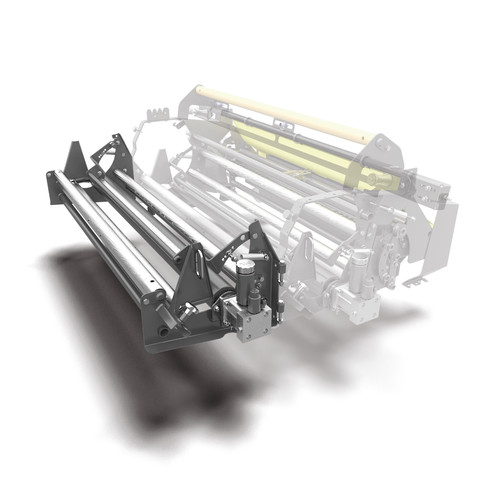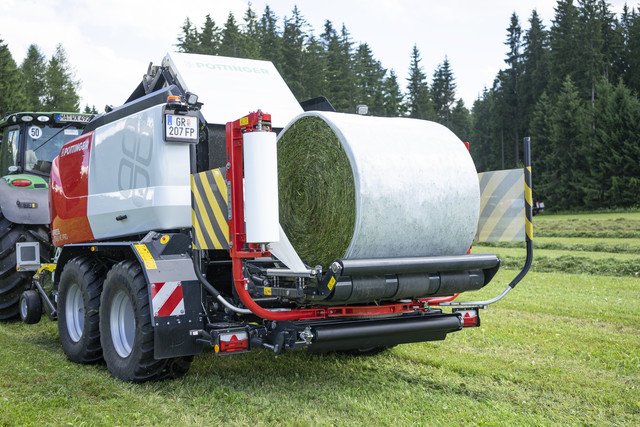Binding unit
×Secure binding
The highest baling pressure, the shortest chopped length and the highest throughput are useless if the binding system does not work reliably. In addition to the binding unit, the binding material and external factors such as temperature and humidity also play a major role.
PÖTTINGER has developed a binding unit to counter these influences that can be adapted to your requirements. The roll holder and hydraulic roll brake controls the roll of net or film from the outside. Damaged cardboard cores are no longer a problem. The braking effect can be conveniently set at the control terminal.

Better guidance
The feed unit ensures that the binding material is reliably fed into the baling chamber at the beginning of the binding process, and is cropped when it is finished.
In order to keep the binding time as short as possible, the feed unit moves into position shortly before the bale is finished, so that it can respond immediately the binding signal is given.
The number of layers and the braking effect can be preselected using the control terminal and saved separately for net and film. The start of the binding process can be triggered manually or using automatic functions.
Modular binding

Regardless of whether you used net or film binding, the basic components are the same. The standard net binding unit can optionally be upgraded to film binding on the PRO models to include an additional roll holder. No matter whether fixed chamber or variable chamber, whether solo (F/V) or combined with a wrapper (FC/VC).

Net wrapping
The standard binding unit includes a roller holder with a hydraulic brake. The net is pulled wide in the guide unit up to the edges of the bale or, depending on the net width, over the edges.
Cylindrical bales without shoulder formation are the result. Perfect for wrapping, transport and storage.
The maximum size of the binding material roll is 310 mm in diameter and 1,400 mm wide.

Film binding
The standard roll holder can be upgraded to film binding by adding a tail binding unit. Tail binding means that the film is tied in a braid for feeding into the baling chamber and cropping at the end. This improves the feed-in performance and increases reliability. The binding process can be monitored using the camera installed.
It is possible to switch between net and film by changing the roll and feed-in as well as preselecting the setting at the control terminal.

Second roll mounting
The additional roll holder with roll brake saves you the effort of removing and inserting the heavy rolls when changing between film or net. Both types of material can be installed and then changed quickly and easily by manual threading. When selecting the new binding material, the control terminal always retrieves values last saved for the number of layers and brake settings.
The second roller mount pivots to improve accessibility.
Perfectly sealed

Using binding film prevents the bale from expanding when it leaves the baling chamber.
Depending on the number of layers of net applied and the type of net used, the bales can expand by up to 3 cm in diameter after ejection. This expansion corresponds to a volume of 70 litres with a bale diameter of 1.25 metres. The resulting additional volume allows air to enter the bale, which inhibits the fermentation process. Binding film can be pre-stretched to a greater extent to prevent expansion. The density of the bale remains constant and no air can enter. This provides optimum conditions for the fermentation process.
All-round protection
The binding film, which is tightly stretched over the entire width and even over the edges, prevents shoulder formation and ensures the bale has tidy edges. This means that less air is trapped during the subsequent wrapping process - an additional guarantee for high forage quality.
Damage to the film enables oxygen to enter. At this point, yeasts lead to the development of mould. Binding film significantly reduces this risk, as a more uniform number of layers is provided around the bale. This makes it less susceptible to damage from stubble, animals or during transport.
Improved storage

The binding film provides better protection of the sensitive surface and keeps the bale perfectly in its cylindrical shape, which simplifies transport and storage. When stored upright, as recommended, pressure acts outwards, which additionally presses the film layers together. When the bale is opened, the film separates cleanly from the forage, even in frosty conditions.

Reliable
The film binding unit on the PÖTTINGER IMPRESS works with a tail binder. This ensures reliable feeding, reliable cropping and reliable handling of the film in all operating conditions. The wide stretch unit draws the film out to a width of up to 1,400 mm so that it extends over the bale edges. The braking force applied to the roll of film for pre-tensioning can be adjusted from the tractor cab. Likewise the number of layers - we recommend 4-5 layers.

Sustainable
When using binding film in combination with stretch film to wrap silage bales, two identical types of film are applied on top of each other. This means that they no longer have to be separated from each other for disposal. This not only makes your work easier, it also protects the environment. The waste film material can therefore be recycled much more easily and efficiently.

Economical
By using binding film you increase your forage quality and in turn the performance of your livestock. The reduced expansion of the bales after wrapping keeps the bales in shape so that they require less storage space. Depending on the operating conditions, the number of layers of stretch film can be reduced by 2 during the wrapping process if the bale has been secured with 4 to 5 layers of binding film.
